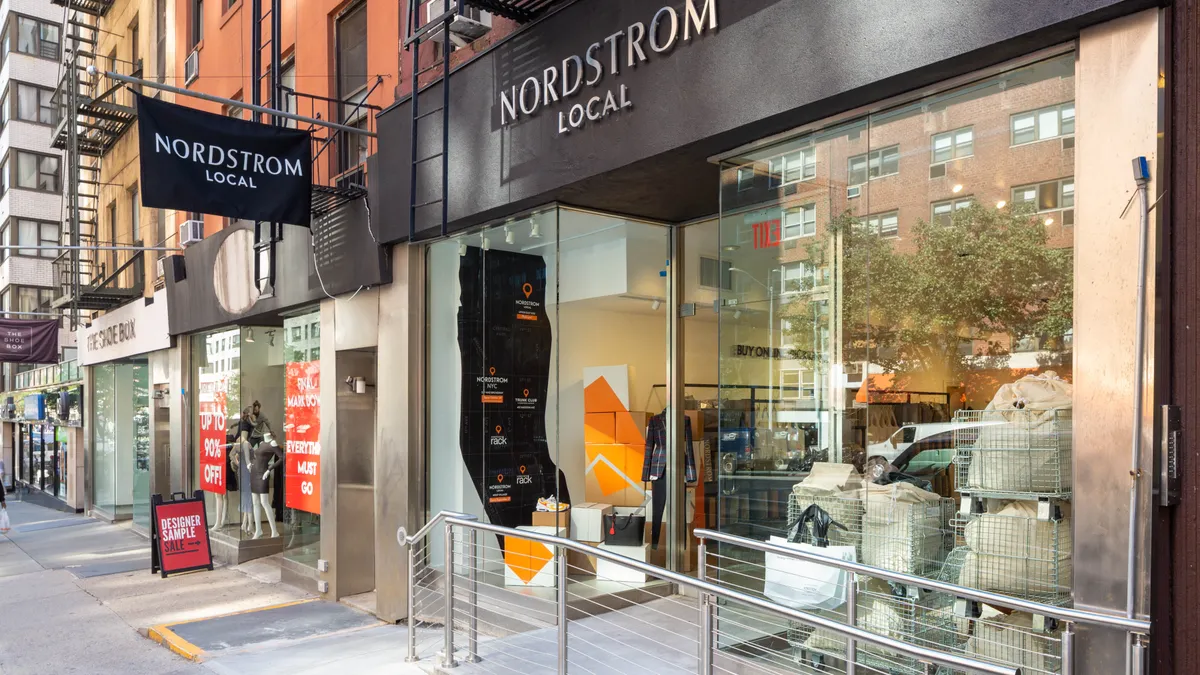Dive Brief:
-
Nordstrom shares edged up early Monday after J.P. Morgan upgraded the stock to "neutral" and boosted its price target to $41 from $26 per share. The analysts cited inventory improvements, fewer markdowns, recovery in its off-price Rack unit, accelerating e-commerce and by online, pick up in-store (BOPIS), and its location in mostly premium malls, among other factors, for the upgrade.
-
The department store's inventory picture is a stand-out among its peers. J.P. Morgan analysts noted that the retailer exited the third quarter with "clean" inventory that was 420 basis points below executives' fourth quarter expectations "or a 1,530bps positive reversal from a year prior," per a client note emailed to Retail Dive.
-
Analysts called the Nordstrom Local expansion along with its new flagship in New York City, a "potential accelerator" with a "market halo effect."
Dive Insight:
Nordstrom was already closing out the year by separating from the department store pack, and the J.P. Morgan upgrade served to make that all the more stark.
The analysts noted three multi-year "structural differences" between Nordstrom and its peers. First, that 95% of its store base is in grade-A malls; second, that e-commerce represents 34% of sales but hasn't hurt margins compared to in-store sales, and its omnichannel prowess is thanks in part to accelerating BOPIS services; and, third, that its financial picture is set to improve, with capital investments shrinking to 3% to 4% of sales from the 6% today (presumably before the New York City flagship was complete).
They also noted the superiority and diversity of its merchandise, including private label and emerging brands as well as legacy ones. "[W]hile not 100% exclusive our work points to multiple examples of assortment 'differentiation' expanding 'destination' status," they wrote, noting that Nike named Nordstrom among its top 40 vendors and that Vince has discontinued wholesaling to Bloomingdales.
Indeed, the department store's clean inventories stand out, especially compared to the likes of Macy's and Kohl's. MKM Partners analysts last week warned that bloated inventories may have helped render the past season the "most promotional holiday since the recession." Again, Nordstrom's Local strategy comes into play, according to J.P. Morgan, which called it a "game-changer" thanks to the ability to speedily move merchandise to eight stores in the New York region.
That's important for Nordstrom. While it's seen as a West Coast retailer thanks to its Seattle roots and concentration in the region, co-president Erik Nordstrom told analysts at a management meeting at the New York Stock Exchange in October that New York represents a $700 million-plus market. In the city, the company runs six off-price Rack stores (two in Manhattan), a men's store opened last year, and two recently opened merchandise-free Local stores, as well as other full-line and off-price stores in the wider Tri-State area.
The year won't offer smooth sailing for any department store, however, and that includes Nordstrom. The full-price trajectory could be interrupted by the need for discounts in e-commerce and through the loyalty program. And while J.P. Morgan analysts noted that the retailer's target higher-income customer has recovered since their downgrade of Nordstrom a year ago, the economy this year could undermine that.
Still, the diminished presence of Barneys, Hudson's Bay Co. (which owns Saks) and Lord & Taylor could present Nordstrom with "a multi-year market share opportunity," analysts said Monday.













